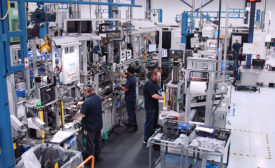Home » error-proofing
Articles Tagged with ''error-proofing''
New software tools help engineers enforce production processes
Read More
Virtual Templating with Laser Projection
Laser projection allows companies to speed up welding processes, minimize the use of templates and tools, eliminate errors, and improve quality
September 12, 2019
Tool Balancers and Support Arms
Traditional tool balancers and evolving support arms boost worker efficiency and safety
July 10, 2019
What’s New With RFID
RFID technology has become critical for assembling cars, appliances and other high-value, high-mix products.
August 7, 2017
2016 Assembly Plant of the Year: Bosch Rexroth Flexes Its Lean Production Muscle
High-mix lines and continuous improvement drive growth in Fountain Inn, SC.
October 1, 2016
Bullet-Proof Automated Assembly
A system that runs like clockwork doesn’t happen by accident.
September 8, 2016
advertisement
How to Provide Maximum Processing Reliability on a Manual Screwdriving Workstation
March 8, 2016
advertisement
How To Add Cost-Effective Error-Proofing to Your Screwdriving Application
March 8, 2016
Never miss the latest news and trends driving the manufacturing industry
Stay in the know on the latest assembly trends.
JOIN TODAY!Copyright ©2024. All Rights Reserved BNP Media.
Design, CMS, Hosting & Web Development :: ePublishing












